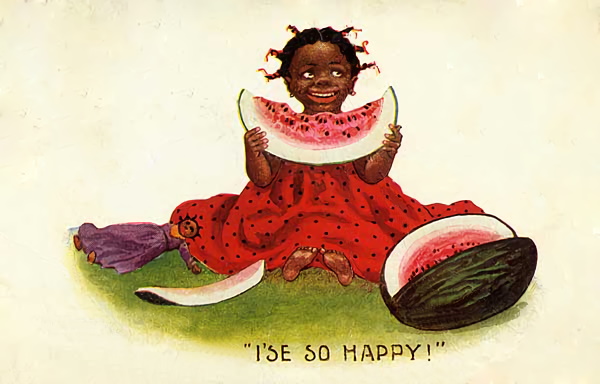Black Stereotypes
In class, we discussed two black stereotypes. The first was that blacks can't swim/don't like water. The other was the "Mammy" figure of a nice old (and often obese) black lady who loves taking care of white children and especially loves to cook for them; Aunt Jemima being one example. For my blog I decided to research on some more stereotypes about black people.
 We are all familiar with the common black stereotypes still used today in movies and other areas which often depict black people as more violent/criminal, swearing more and lacking self control. They are also portrayed as being less educated and more athletic. Less common are stereotypes about the kinds of food that black people enjoy. Fried chicken comes to mind, but blacks are also associated with being especially fond of watermelons and waffles.
We are all familiar with the common black stereotypes still used today in movies and other areas which often depict black people as more violent/criminal, swearing more and lacking self control. They are also portrayed as being less educated and more athletic. Less common are stereotypes about the kinds of food that black people enjoy. Fried chicken comes to mind, but blacks are also associated with being especially fond of watermelons and waffles.
But there are many archetypal stereotypes which were very widespread during the 19th and 20th century. Variations of these figures were often used as characters in many popular shows and books of the time.
One is Blackface, which depicted blacks as unintelligent animals who were ignorant, lazy, superstitious, and loved music. Jim Crow was a popular character depicting this archetype. A more severe version of this was the Savage, in which blacks were depicted as cannibalistic tribal cave-men who were very childish and easily fooled by white men.
Another is the Tragic Mulatta, a mean and unsympathetic mixed race woman who could pass for being white. She was very ambitious, her end goal being to marry a middle class white man and settle down. In the end she always had to accept her "blackness".
 Mammy's male counterpart is the Uncle Tom stereotype of a man who is unintelligent and simple-minded yet content. Uncle Ben as well as Jim from Huck Finn are examples of these.
Mammy's male counterpart is the Uncle Tom stereotype of a man who is unintelligent and simple-minded yet content. Uncle Ben as well as Jim from Huck Finn are examples of these.
There are many more which I don't have time to write about. For more information, look here and here.
Obviously, these stereotypes are no longer used today, but they show the extent of the racism that was so prevalent during and immediately after the time of slavery.
 We are all familiar with the common black stereotypes still used today in movies and other areas which often depict black people as more violent/criminal, swearing more and lacking self control. They are also portrayed as being less educated and more athletic. Less common are stereotypes about the kinds of food that black people enjoy. Fried chicken comes to mind, but blacks are also associated with being especially fond of watermelons and waffles.
We are all familiar with the common black stereotypes still used today in movies and other areas which often depict black people as more violent/criminal, swearing more and lacking self control. They are also portrayed as being less educated and more athletic. Less common are stereotypes about the kinds of food that black people enjoy. Fried chicken comes to mind, but blacks are also associated with being especially fond of watermelons and waffles.But there are many archetypal stereotypes which were very widespread during the 19th and 20th century. Variations of these figures were often used as characters in many popular shows and books of the time.
One is Blackface, which depicted blacks as unintelligent animals who were ignorant, lazy, superstitious, and loved music. Jim Crow was a popular character depicting this archetype. A more severe version of this was the Savage, in which blacks were depicted as cannibalistic tribal cave-men who were very childish and easily fooled by white men.
Another is the Tragic Mulatta, a mean and unsympathetic mixed race woman who could pass for being white. She was very ambitious, her end goal being to marry a middle class white man and settle down. In the end she always had to accept her "blackness".
 Mammy's male counterpart is the Uncle Tom stereotype of a man who is unintelligent and simple-minded yet content. Uncle Ben as well as Jim from Huck Finn are examples of these.
Mammy's male counterpart is the Uncle Tom stereotype of a man who is unintelligent and simple-minded yet content. Uncle Ben as well as Jim from Huck Finn are examples of these.There are many more which I don't have time to write about. For more information, look here and here.
Obviously, these stereotypes are no longer used today, but they show the extent of the racism that was so prevalent during and immediately after the time of slavery.
Comments
Post a Comment